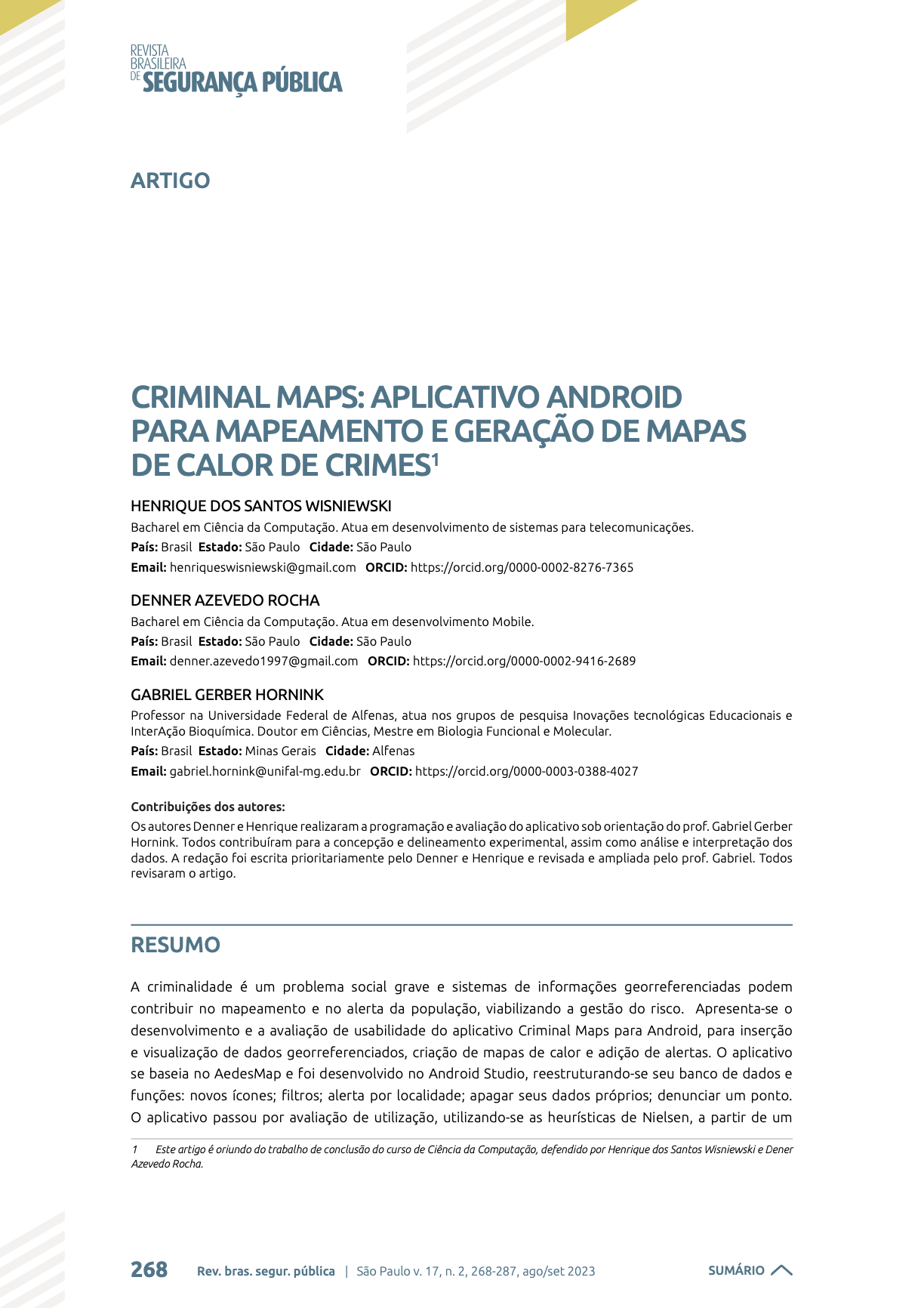Criminal Maps
android application for mapping and generation of heat of crimes maps
DOI:
https://doi.org/10.31060/rbsp.2023.v17.n2.1648Keywords:
Crime map, Georeferenced information system, Heat mapsAbstract
Crime is a serious social problem and georeferenced information systems can contribute to mapping and alerting the population, enabling risk management. The development and usability evaluation of the Criminal Maps Android application is presented, for insertion and visualization of georeferenced data, creation of heat maps and addition of alerts. The application is based on HIDDEN 1 and was developed in Android Studio, restructuring its database and functions: new icons; filters; alert by location; delete your own data; report a point. The application underwent an evaluation of its use, using Nielsen's heuristics, based on a (validated) checklist and the semiotic inspection method (MIS). The results indicated that the application has good usability, as well as potential for use.
Downloads
References
ALMEIDA, D.; SANTOS, M. A. R.; COSTA, A. F. B. Aplicação do coeficiente Alfa de Cronbach nos resultados de um questionário para avaliação de desempenho da saúde pública. Anais do XXX Encontro Nacional de Engenharia de Produção. São Carlos/SP: Associação Brasileira de Engenharia de Produção, out. 2010, p. 1-12.
ANATEL. Infográfico setorial de telecomunicações – fev. 2022. 2022.
AVALOS, H. N.; PEÑA, F. F.; URRUTIA, P. U.; MOROCHO, O. C. Impacto de la georreferenciación colaborativa de actos delictivos en el ciudadano común basada en el modelo de aceptación tecnológica. Revista Ciencia Unemi, v. 12, n. 31, p. 83-94, 2019.
BABICKI, S.; ARNDT, D.; MARCU, A.; LIANG, Y.; GRANT, J. R.; MACIEJEWSKI, A.; WISHART, D. S. Heatmapper: web-enabled heat mapping for all. Nucleic Acids Research, v. 44, p. 147-153, 2016.
BASTOMSKI, S.; BRAZIL, N.; PAPACHRISTOS, A. V. Neighborhood co-offending networks, structural embeddedness, and violent crime in Chicago. Social Networks, v. 51, p. 23-39, 2017.
BORNHOFEN, P. R.; TENFEN, E. Mapeamento criminal por meio da plataforma Google Maps. Revista Brasileira de Segurança Pública, v. 3, n. 2, p. 82-98, 2009.
BRUNO, F. G. Mapas de crime: vigilância distribuída e participação na cibercultura. E-Compós, v. 12, n. 2, 2009.
CRONBACH, L. J.; GLESER, G. C.; NANDA, H.; RAJARATNAM, N. The dependability of behavioral measurements: Theory for generalizability of scores and profiles. Nova York: John Wiley, 1972.
DE SOUZA, C. S.; LEITÃO, C. F. Semiotic Engineering Methods for Scientific Research in HCI. São Francisco/CA: Morgan & Claypool, 2009.
GOOGLE PLAY. Atender ao requisito de segmentação de nível de API do Google Play. [s.d.]
GRIGERA, J.; GARRIDO, A.; RIVERO, J.M.; ROSSI, G. Automatic detection of usability smells in web applications. International Journal of Human-computer Studies, v. 97, 2017.
JIMENEZ, T. C.; SANCHEZ, D. T.; GORDON, S. S.; GUERRERO, J. J.; GUEVARA, C.; ALVAREZ, P. L.; VARGAS, P. A.; ULLAURI, L. S.; NUNES, I. L. Improving usability with think aloud and focus group methods. A case study: an Intelligent Police Patrolling System (I-Pat). In: NUNES, I. (Ed.). Advances in Human Factors and Systems Interaction. AHFE 2019. Advances in Intelligent Systems and Computing, v. 959. Washington: Springer, 2019, p. 361-373.
NIELSEN, J. Usability engineering. Oxford: Elsevier, 1994a.
NIELSEN, J. Heuristic evaluation. In: NIELSEN, J., MACK, R. L. (Eds.). Usability Inspection Methods. New York: John Wiley & Sons, 1994b.
NIELSEN, J. How to Conduct a Heuristic Evaluation. Nielsen Norman Group, 1º nov. 1994c.
NIELSEN, J.; MOLICH, R. Heuristic evaluation of user interfaces. Proceedings of CHI' 90: Conference on Human Factors in Computing. Seattle/USA, 1990, p. 249-256.
MIGUEL, G. A.; BRESSAN, P. A.; HORNINK, G. G. Dispositivos móveis para obtenção de dados georreferenciados da Dengue, Zika e Chikungunya. Infodesign, v. 17, n. 1, 2020.
MIGUEL, G. A.; REIS, T.H. ; GONÇALVES, A.B. ; BRESSAN, P.A. ; HORNINK, G. G. AedesMap Mobile (software). Registro INPI: BR512018000358, Alfenas: UNIFAL-MG, 2018.
STREINER, D. L. Being inconsistent about consistency: when coefficient alpha does and doesn’t matter. Journal of Personality Assessment, v. 80, p. 217-222. 2003. Doi: https://doi.org/10.1207/s15327752jpa8003_01.
SUTHERLAND, J. V.; SCHWABER, K. The SCRUM methodology. In: Business object design and implementation. Proceedings of OOPSLA workshop. Austin: Springer, 1995.
VIZCARRA, A. A. P.; FIGUEROA, G. P. A.; CHANA, J. W. T.; GARCIA-PEÑALVO, F. J. An app based on cooperative learning for the detection of danger points and the prevention of risk areas in a city. Proceedings of XVII International Conference on Technological Ecosystems for Enhancing Multiculturality. Nova Iorque: Association for Computer Machine, 2019, p. 830-837.
WISNIEWSKY, H. S.; ROCHA, D. A.; HORNINK, G.G. Criminal maps (software). Versão 1.0. Alfenas: UNIFAL-MG, 2019.

Published
How to Cite
Issue
Section
License
Copyright (c) 2023 Revista Brasileira de Segurança Pública

This work is licensed under a Creative Commons Attribution 4.0 International License.
Licensing
The Brazilian Journal of Public Security uses the Creative Commons License as a form of licensing for its published works. The license used follows the CC BY 4.0 - Attribution 4.0 International model.
To see the permitted rights please go to the full licence or to our Copyright and Licensing page.


